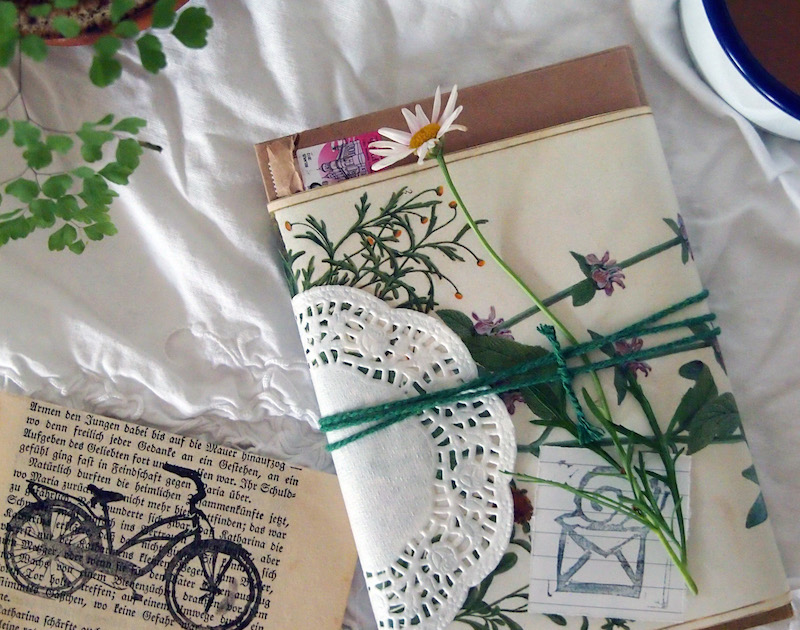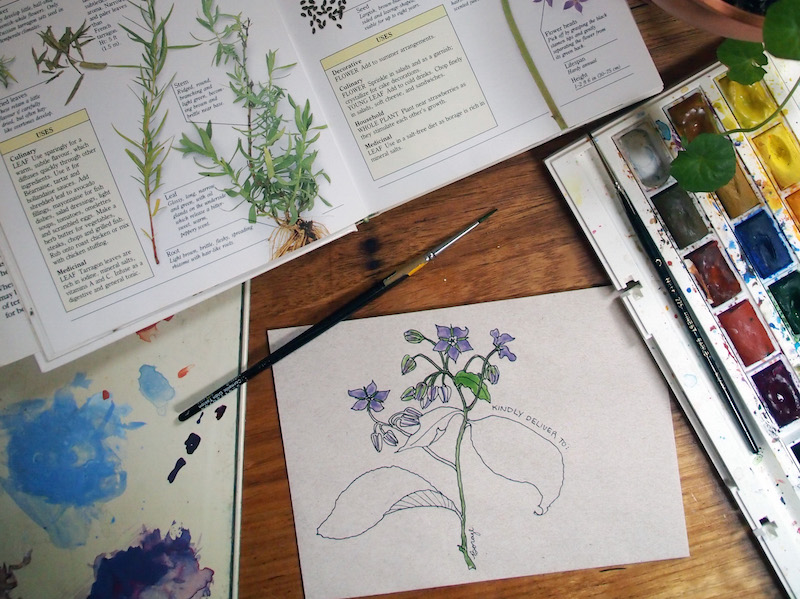
JOURNAL
documenting
&
discovering joyful things
Valma's letters
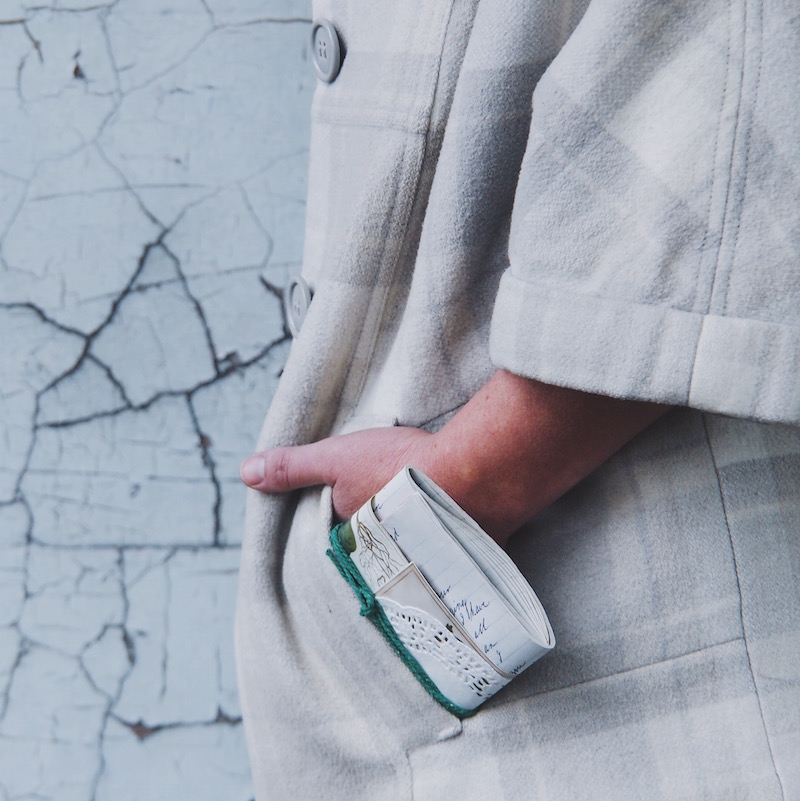 When I was a teenager, an old lady named Valma used to write me the longest letters. Easily 20 pages or more, in scrawling cursive on foolscap paper.
When I was a teenager, an old lady named Valma used to write me the longest letters. Easily 20 pages or more, in scrawling cursive on foolscap paper.
Valma and her husband Bill lived in a two-room hut on a little dirt road called Saddler's Lane, and I came to know them because I would ride by their place on my way to a creek at the bottom of the valley. When she heard the clop-clop of my horse's hooves, Valma would rush towards me to say hello: she got around with a funny swinging motion on two crutches, because her legs didn't work. We'd stand and chat at her old farm gate while my horse grazed nearby.
Valma would never accept my invitations to come tea at our place. She said she was too embarrassed to ever return the hospitality because her house had no floor, just beaten earth, and no water.
Sometimes I would bring her gifts of fruit from our trees, or a slice my mother had made, and hand them to her over the farm gate. After we moved away and I couldn't ride past any more, Valma and I became irregular pen pals for many years, up until she died.
Then a few months ago my parents brought some papers to my place, and Valma's letters were among them. All those memories of our old friendship came flooding back...
My one weakness
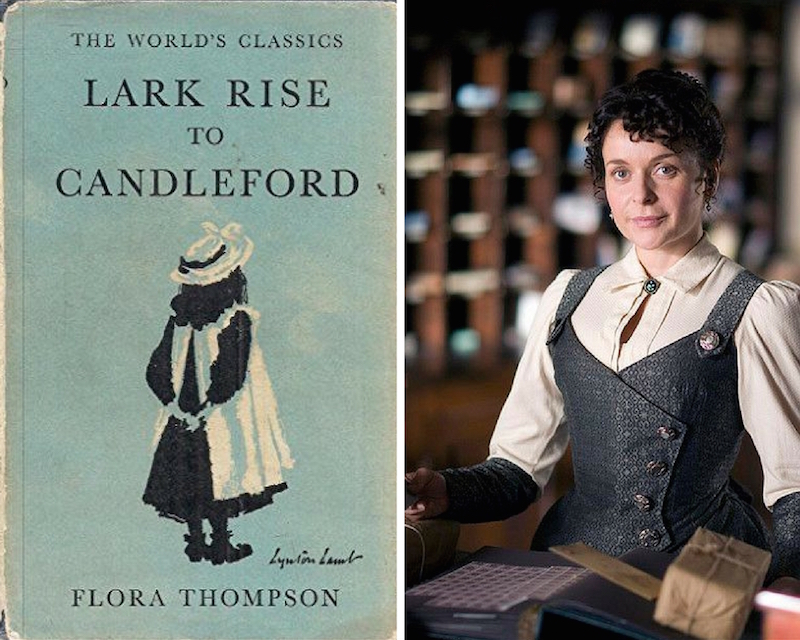
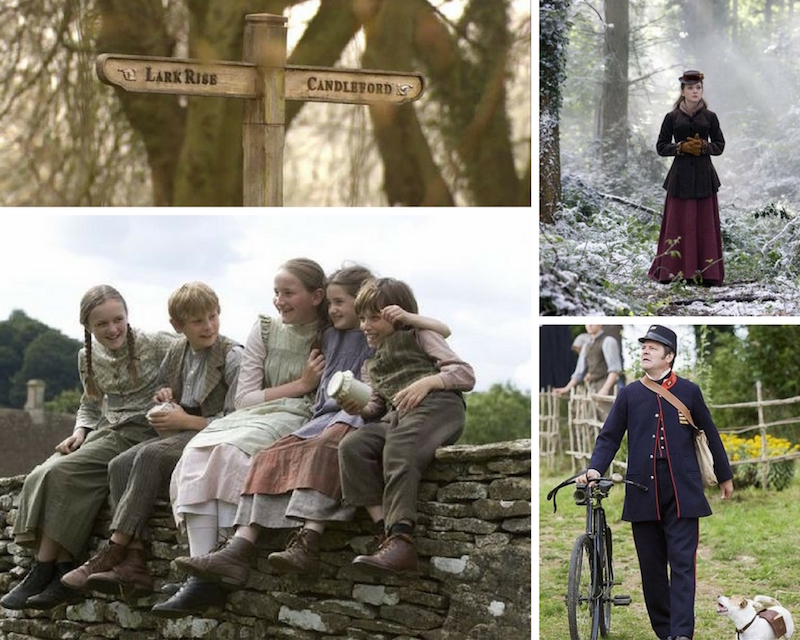
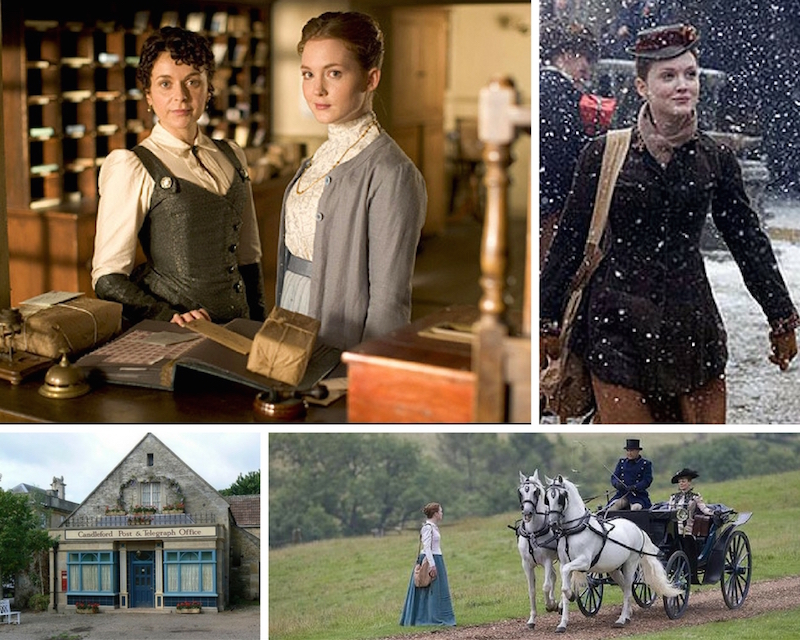
Recently, I had a conversation on this blog with a lovely reader called Jan. I'm paraphrasing, but the conversation went something like this:
Jan: Have you heard of the TV show "Lark Rise to Candleford?" It's a period drama set in a post office.
Me: *Instantly leaves office and runs to find it*
Now I'm up to Season 2, and utterly in love with this little show. It is gentle, thoughtful, innocent, warm-hearted, and makes me feel nostalgic for a kind of life I've never known.
In case you haven't heard of it, Lark Rise to Candleford (which is based on a semi-autobiographical trilogy of books of the same name by Flora Thompson) centres around two small rural communities at the turn of the 19th century: the tiny hamlet of Lark Rise, and the wealthier and bigger (but still tiny by our standards) town of Candleford, both in Oxfordshire in the UK.
When in Candleford, most of the action centres around the comings and goings of the Candleford Post Office, which is run, rather controversially, by a woman. The Post Mistress, Dorcas Lane, is truly delightful: wise, loving, independent, glamorous, and ahead of her era in so many ways. She claims to have "one weakness," although depending on the circumstance, that one weakness could be anything from cake to feather pillows to buttermilk baths.
When Laura, Dorcas' young niece from Lark Rise, comes to work at the Candleford Post Office, Dorcas takes her under her lovely, protective wing and teaches her the way of the world... and of the post. I have been learning right along with Laura as I watch, and here is what I've gleaned so far:
* A century ago, the post was the only real way that people could communicate with others at a distance. It was possibly the most essential community-service of the time
* The post office itself was a community hub. All but the most hardened recluse had need of the postal services at some time or another so, in small communities, it became a natural meeting place for neighbours to gather and chat and swap stories and gossip. To "pass the time of day," as Candleford or Lark Rise folks would call it
* Postal workers were the keepers of secrets. They knew who wrote to whom, and how often. They could see the looks on faces - the shakes of hands - when letters of import were posted or received. They knew the contents of every telegram even before the recipients did
* The postie knew everyone in the community. Letters were delivered not into boxes but into hands, and the route to every home was an opportunity to observe and greet and forge connections
* And this, a quote from Season 4 (which I haven't actually seen so no spoilers please!), which sums up rather beautifully the power of a pen-and-ink letter:
"When words are written down, they can be the finest expression of the human soul... Once words are marked down on paper, they can not be taken back. They are in the world for good or for ill. They wither or they endure. Words can be dangerous things."
10 "slow living" unsung heroes of Instagram
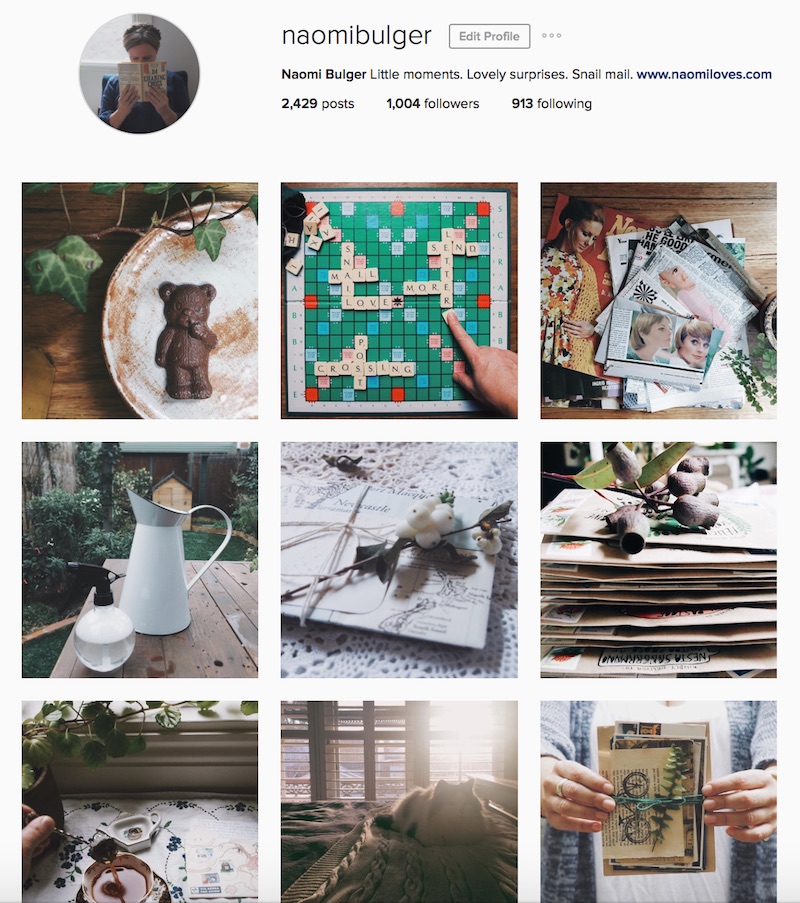 Are you on Instagram? That's me above. I'm @naomibulger if you'd like to drop by and say hi.
Are you on Instagram? That's me above. I'm @naomibulger if you'd like to drop by and say hi.
Who do you like to follow on Instagram? I love to fill my feed with people who inspire me and, these days, more often than not, people who inspire me are people who I like to call "slow-living heroes."
Creative folk, gentle folk, mindful folk. You know the sorts of folks I'm talking about! They are makers and bakers; gardeners and gatherers; weavers, wordsmiths and wanderers; snail-mailers, and spreaders-of-kindness.
Here are 10 of my favourite slow-living Instragrammers, each of them "unsung heroes," because they have relatively small accounts, of 1000 followers or less.
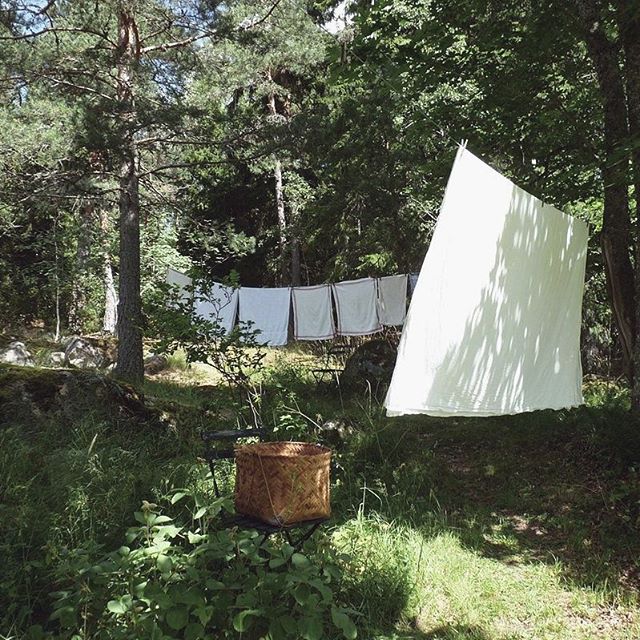 ⇑⇑ @lomoens
⇑⇑ @lomoens
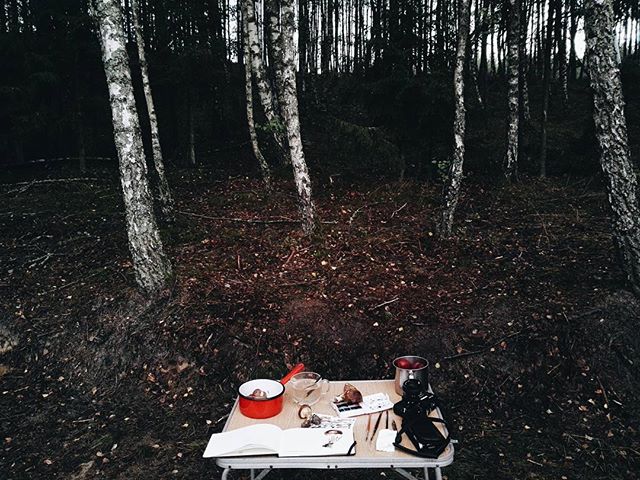 ⇑⇑ @anianycz
⇑⇑ @anianycz
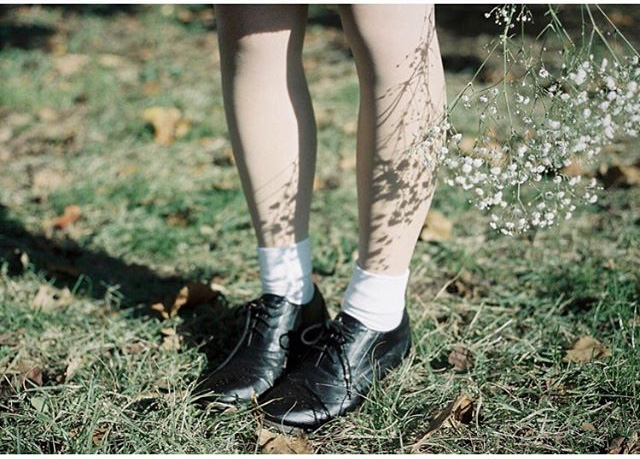 ⇑⇑ @lullaby0720
⇑⇑ @lullaby0720
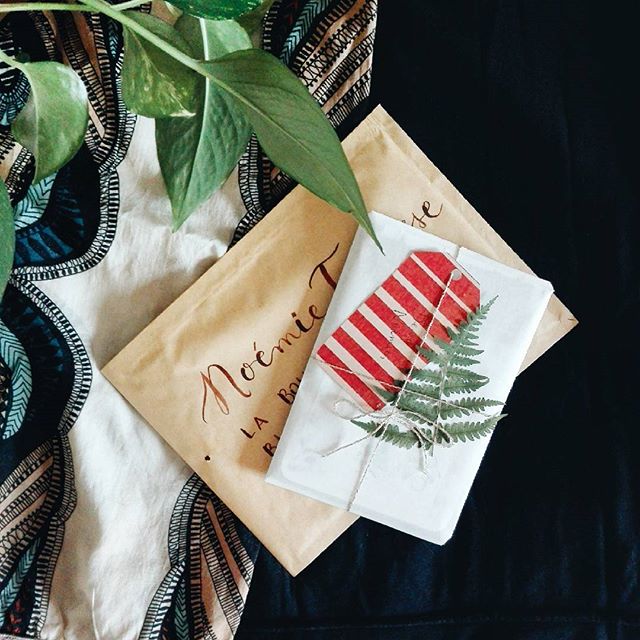 ⇑⇑ @sovica4
⇑⇑ @sovica4
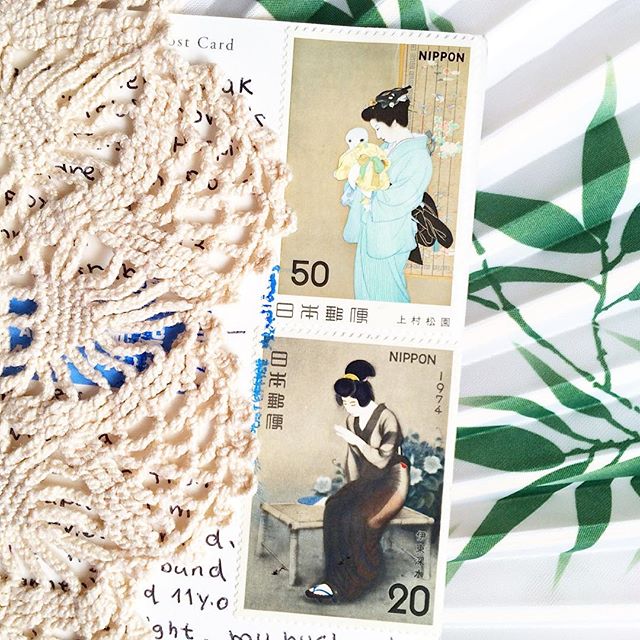 ⇑⇑ @bsvitlana
⇑⇑ @bsvitlana
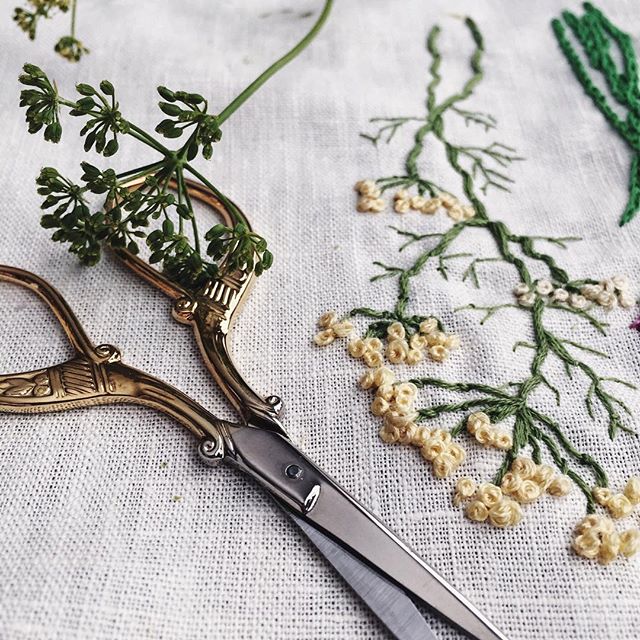 ⇑⇑ @oandystudio
⇑⇑ @oandystudio
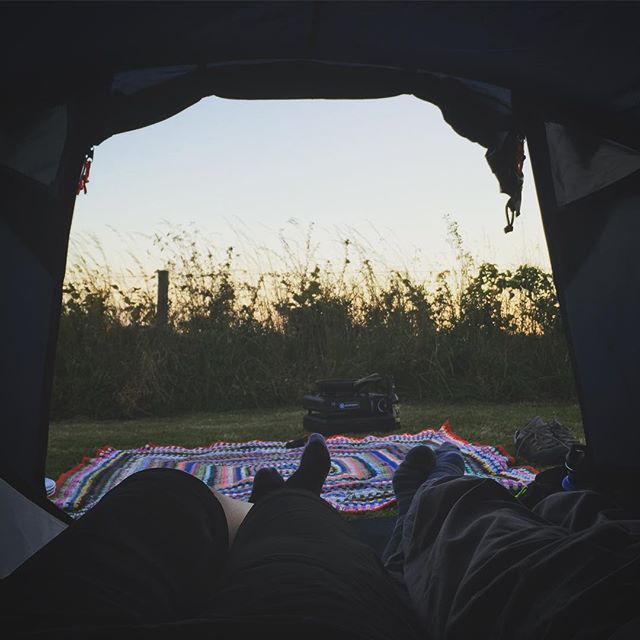 ⇑⇑ @gemmagarner
⇑⇑ @gemmagarner
Who else should I be following? Link me up!
Wonder, mystery, and surprise
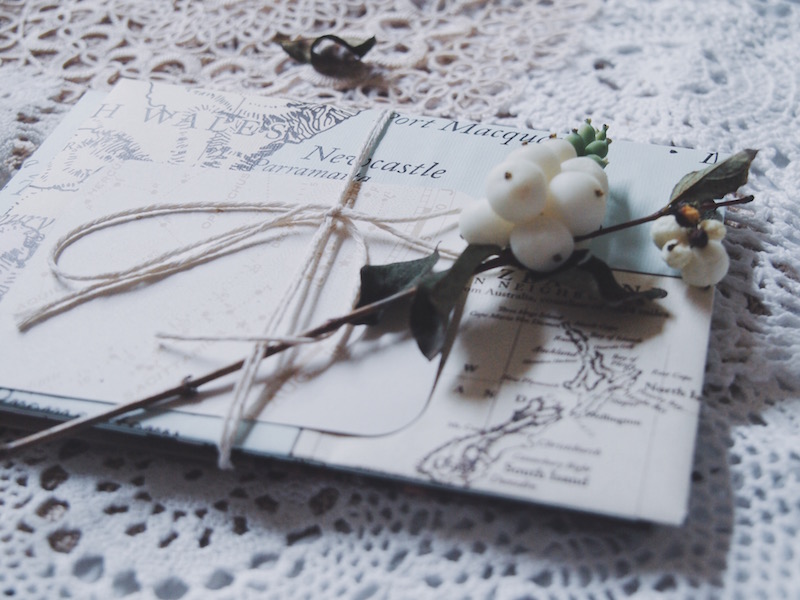 Do you like surprises? Good surprises, I mean.
Do you like surprises? Good surprises, I mean.
Messages in bottles
Friends dropping by
Work promotions
Letters in the mail
Found treasure maps
Clothes bought online that actually fit
The kids eat what you cook
Winning competitions
Surprise parties
Money in last year's coat pocket
Flash mobs
Rainbows
Unexpected public holidays
The first flower of spring
Earlier this week I came across Surprise Industries, a group that is dedicated to creating and spreading good, happy surprises to strangers everywhere. Their simple mission is to add more wonder, mystery, and surprise to your life. Oh, I want to be them! Imagine if "giving surprises" was your life's work!
Would you like a surprise? You can sign up to receive one by joining "The Experiment" by Surprise Industries.
Banking on even the anticipation of a surprise giving you a happy little tingle, Surprise Industries promises:
"At some point in your life, we may surprise you. The surprise may be an anonymous letter, an invitation to a secret location, or anything in between. It might arrive tomorrow, 12 years from now, or never, but if you don’t sign up, you’ll never know."
The cost to join in goes up $1 per person for every 100 participants. I just took part, and it cost me a grand total of $3. Now, I wait. And while I do, it will be with the sometimes goose-pimply shiver of pleasant things to come...
Mail art - fruits of the forest
 These envelopes are sisters to my last post. That collection was all about the wee small creatures of the forest. This one celebrates the fallen leaves, berries, flowers, pine-cones, gum-nuts and fungi to be found in the canopy and on the forest floor, if you chance to look.
These envelopes are sisters to my last post. That collection was all about the wee small creatures of the forest. This one celebrates the fallen leaves, berries, flowers, pine-cones, gum-nuts and fungi to be found in the canopy and on the forest floor, if you chance to look.
"I don't care what town you're born in, what city, what country. If you're a child, you are curious about your environment. You're overturning rocks. You're plucking leaves off of trees and petals off of flowers, looking inside, and you're doing things that create disorder in the lives of the adults around you." Neil deGrasse Tyson (scientist)
Let's all behave like children, shall we?




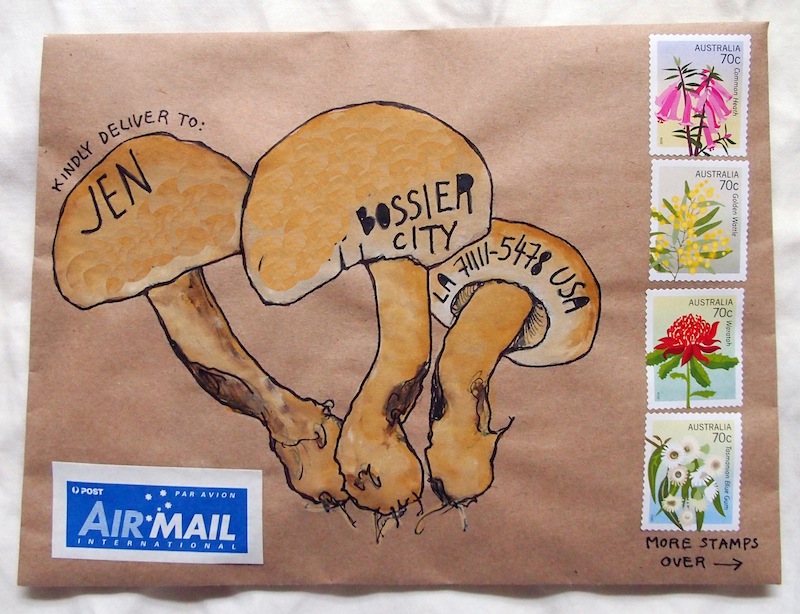

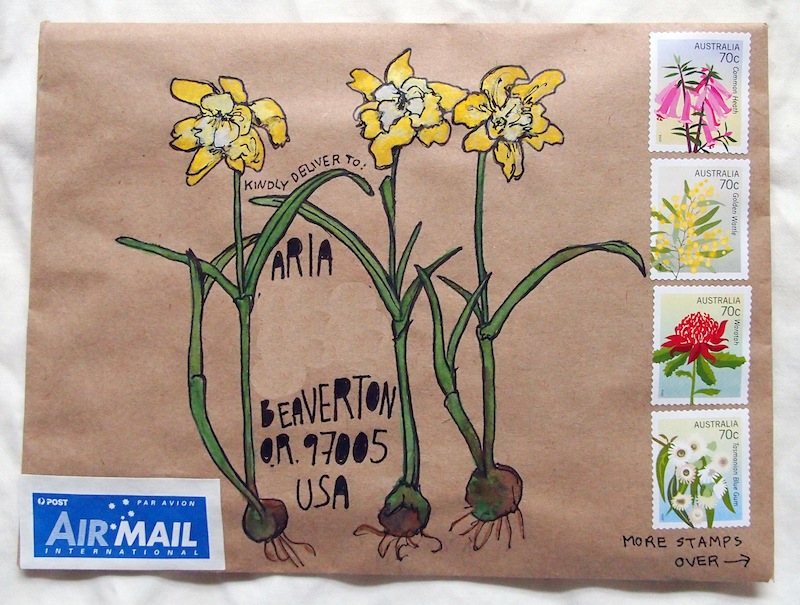
Mail art - friends of the forest
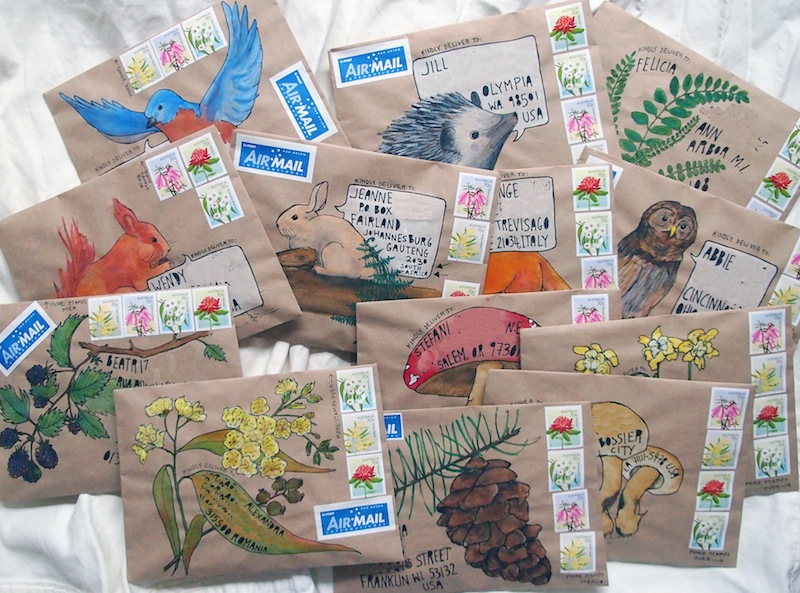 "I'm so happy!" sang Benjy, as he slipped off his boots. "No more London! No more noise of buses and trams! No more poor sooty old trees! But clean sweet bushes and woods, bright flowers, singing birds and shy little animals slipping by. Oh, what fun!"
"I'm so happy!" sang Benjy, as he slipped off his boots. "No more London! No more noise of buses and trams! No more poor sooty old trees! But clean sweet bushes and woods, bright flowers, singing birds and shy little animals slipping by. Oh, what fun!"
This passage is from The Children of Cherry Tree Farm, by Enid Blyton. I loved this book so much as a child, and read it over and over. The children in the book made friends with all the animals on the farm, and in the woods nearby, and it taught me lessons I still remember today about respecting the natural order of things. That frequent Enid Blyton theme: the healing power of Mother Nature.
So I dedicate this latest batch of mail-art to Enid and her happy band of children on Cherry Tree Farm, and to all the wild animals of the forest.
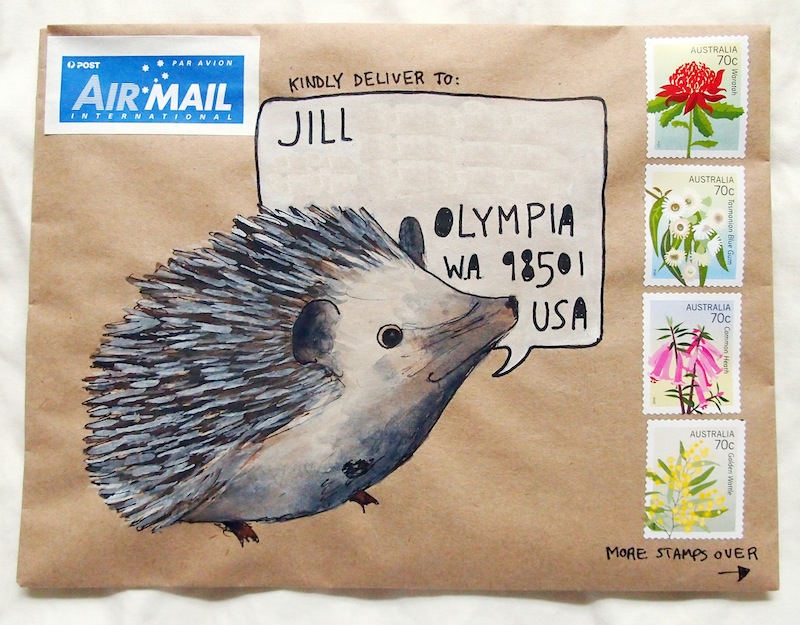
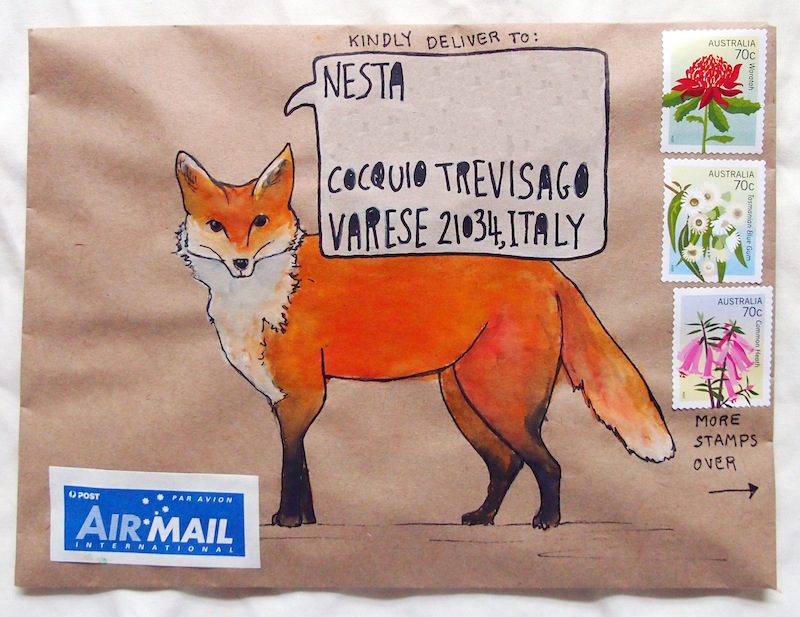
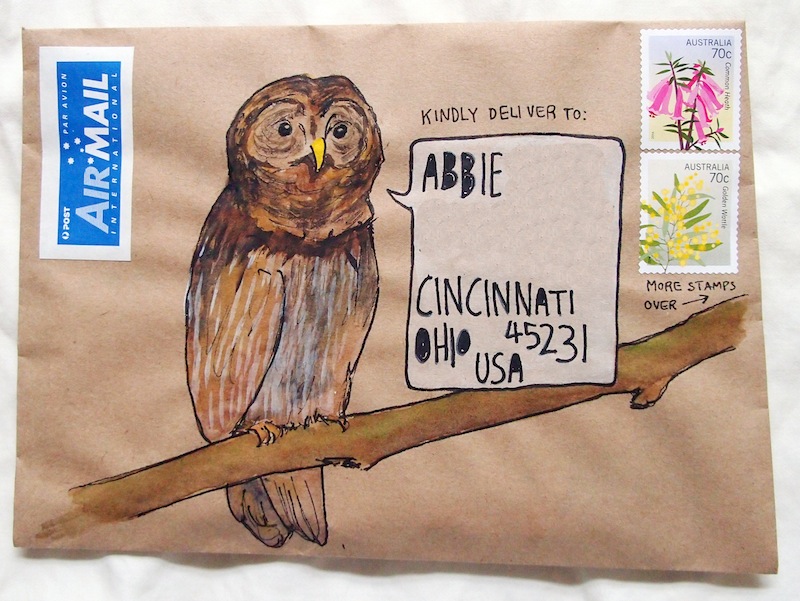

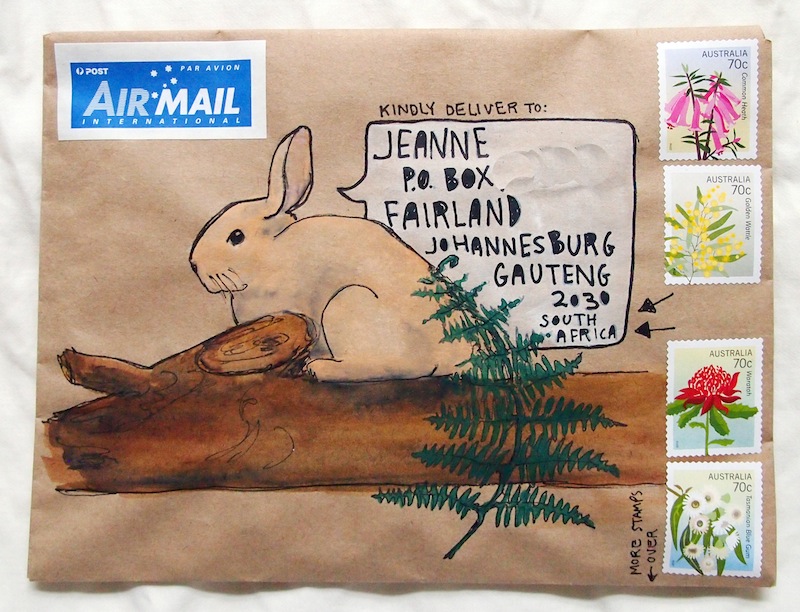
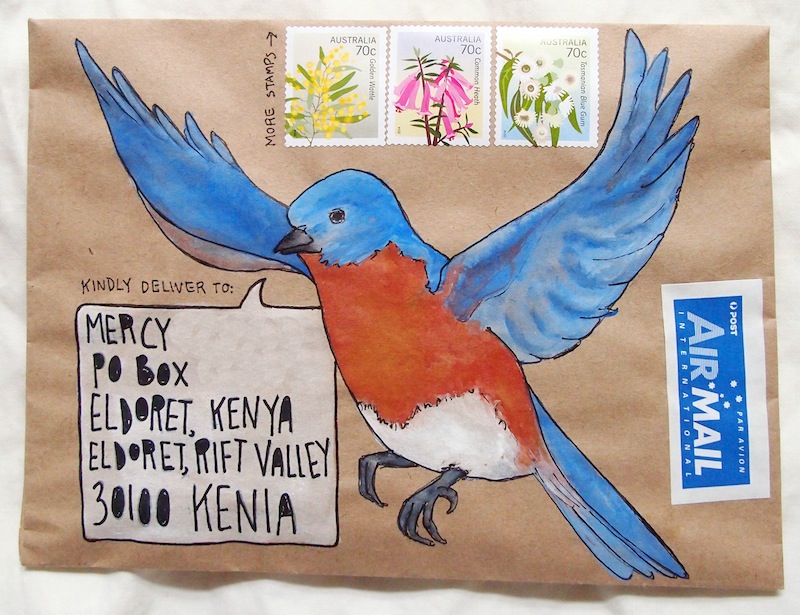
Playing hooky
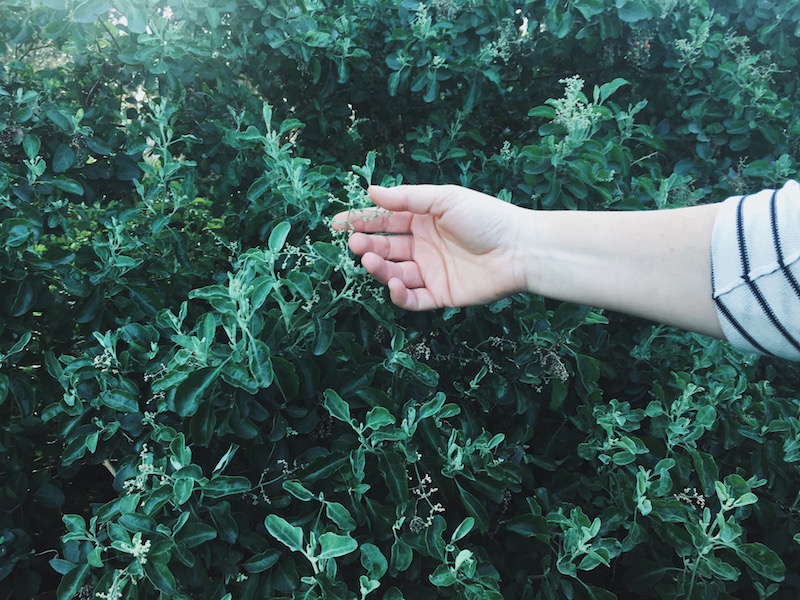
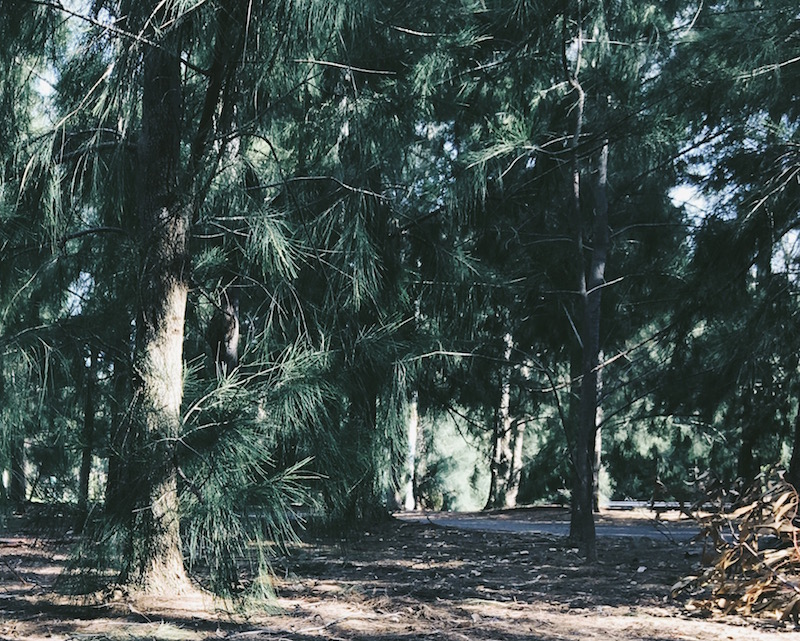
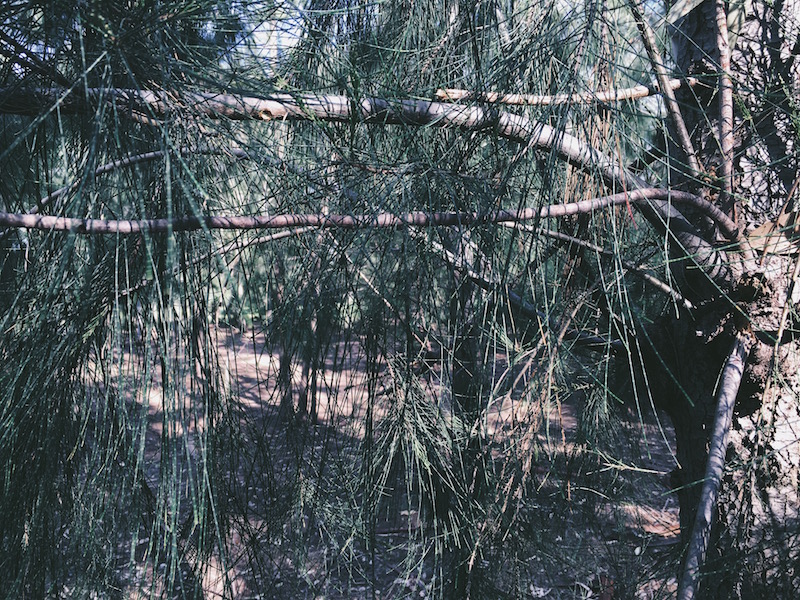
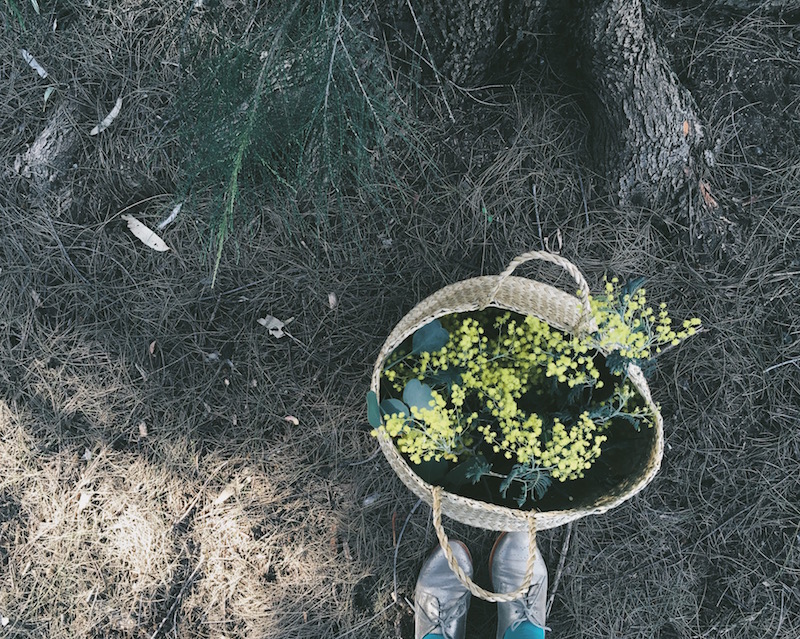
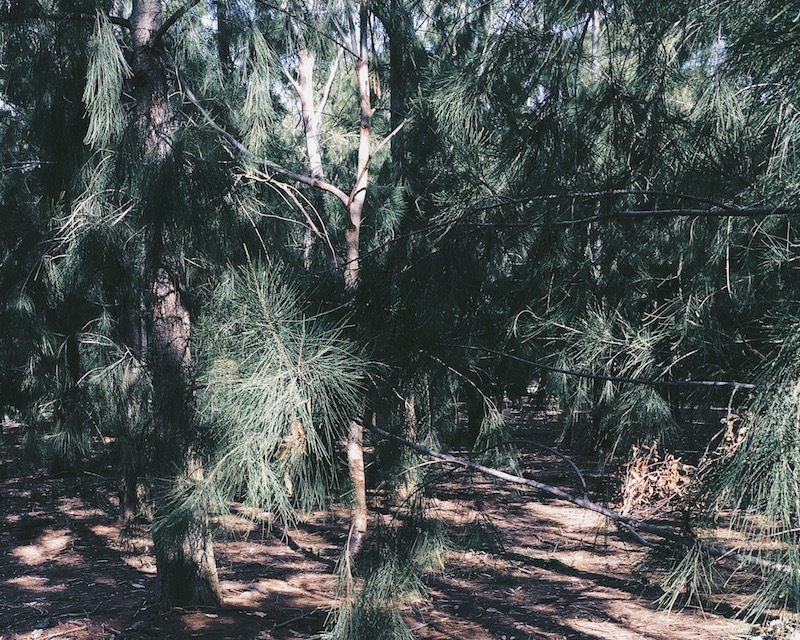
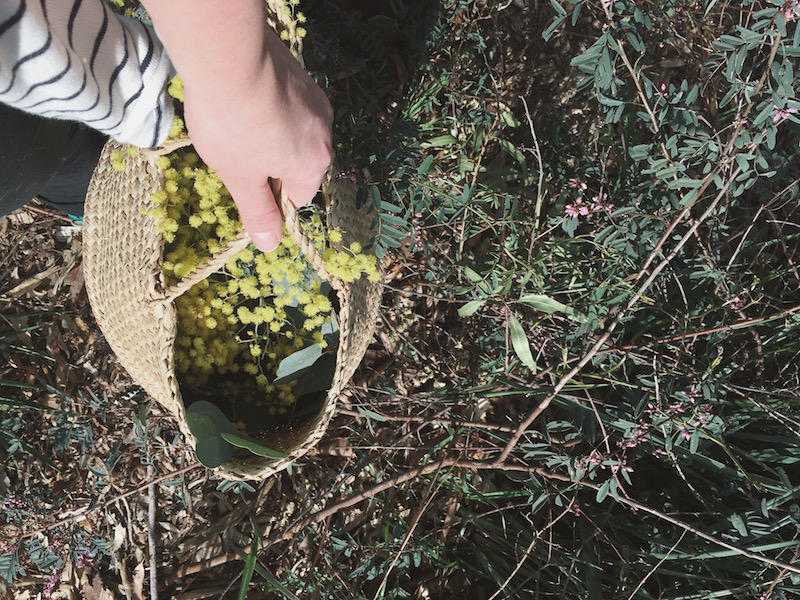
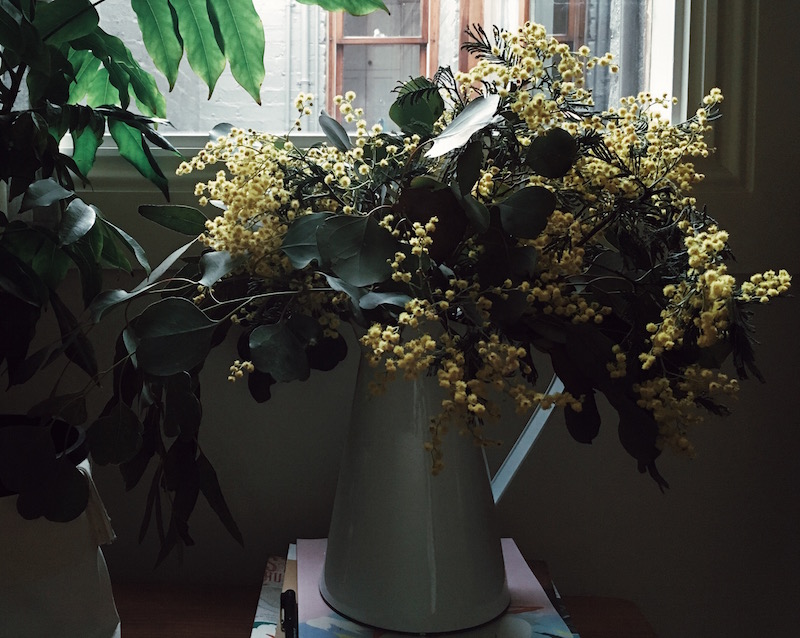
I found a forest!
Well, not really, it was more like a tiny clump of trees. Jane Austen would probably have called it a copse, or something. But in any case it was green and gloomy in the best of ways, and the pine-needles that softened my every foot-fall were made maculate by patches of sun blossoming over the shade.
Yesterday Winter played dress-ups as Spring, and it was the most glorious day you could ever see. All morning, I kept leaving my tiny cupboard of a windowless office to see what the garden was making of this gift of a day.
(Here is the tally: two more daffodils burst into bloom, bringing the total to three; tiny buds appeared all over the once-bare pomegranate tree; the daphne bush tossed perfume willy-nilly into the temperate air; and the snowflakes? the snowflakes burst into bloom by the hundreds.)
And then I would go back into my study and work some more. Read, research, write. Carefully crafted words, self-editing, crafting some more.
But my heart was in the sunshine, in the unexpected warmth of the breeze. And, by mid-afternoon, I couldn't take it any more. I hit "save" on my unfinished story and stepped out into the day, into that false, imaginary spring, and went exploring.
I let my feet take me wherever they would, following parks linked within parks like chains, all over north Melbourne. I foraged wattle and snow-gum leaves and gumnuts, and then I walked some more. When I found the tiny forest, I sat down on the soft, dry pine-needles, closed my eyes, and breathed in the silence.
Breathed it in, breathed it out. In again, out.
As I walked home, carrying my basket of leaves and flowers, it was with a lightness that would suggest I, too, had put on Spring for a day. Even the work that was waiting for me at home, which endured well into the night, could not dampen my spirits. I put my botanical bounty into a big old jug, and got typing.
A touch of green. Some inspiration for you
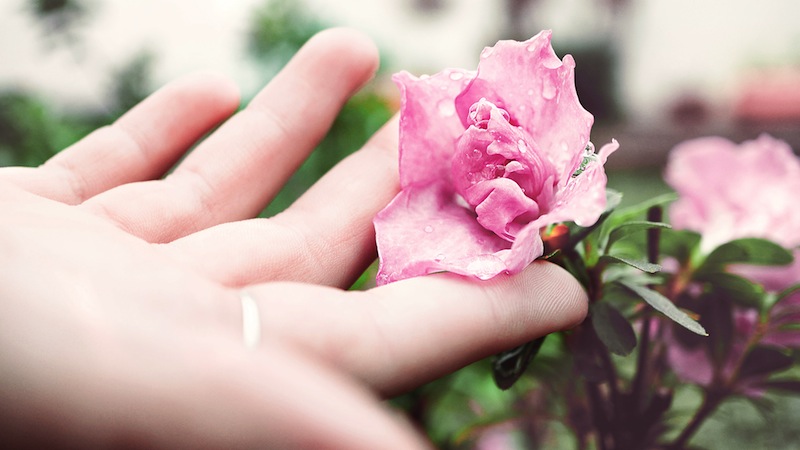 “A garden to walk in and immensity to dream in - what more could he ask? A few flowers at his feet and above him the stars.”
Victor Hugo, Les Misérables
“A garden to walk in and immensity to dream in - what more could he ask? A few flowers at his feet and above him the stars.”
Victor Hugo, Les Misérables
* I'm not ordinarily a fan of embroidery as art on the walls, but I'd make an exception for these little vegetable bouquets
* What a lovely alternative to flowers in vases
* This spring salad looks beautiful and sounds delicious
* I've never seen an office organiser like this. So pretty!
* Such a pretty expanding origami pot for plants
* Always walk on the grass
* I would like to live here, please
* Really love these lazy season pots
* Sweet little mini vertical garden made from vintage jars and bottles
* Where to find free botanical artwork
* Potted plants in Taipei
* Wouldn't these edible terrariums be wonderful for a garden party!
* So much inspiration for your indoor plants
* Nature bingo looks like fun!
* Gorgeous waterfall of leaves
* Perfect for summer nights: caramelised pear salad with goats cheese toast
* The Forest Feast for Kids: Colorful Vegetarian Recipes That Are Simple to Make
* How to make natural dyes from plants and flowers in your garden
Image credit: photo by Jaime Spaniol, licensed for unlimited use under Creative Commons
A recipe for mail-art
I have been so busy making mail lately! Cutting out little packets of handmade stickers and labels, collecting vintage stamps, hunting for postcards old and new, photocopying old recipes and household tips that once belonged to my great-grandmother, then bundling them all up together in handmade envelopes from old catalogue pages, melting green or red wax over the fold, and sealing them shut with a big, bold N.
Lately I've noticed that a lot of you guys have been using the comments section of this blog to ask for tips and tutorials on how to create mail-art. So I'll do my best to oblige you in this post but, to be honest, the beauty of mail-art is that there are no rules and no standards. No tests to pass, no clubs to join, nobody to judge the "artistry" or talent of your work. Or mine. If you put some creative effort into it, and if you call it mail-art, it is mail-art.
That being said, here's the process of how I personally choose to whip up a batch of mail-art (and if you're new to this blog, samples of the finished products are here).
Ingredients:
* Brown kraft paper * Scissors * Glue-stick * Pencil (I use 2b) * Eraser * Pencil-sharpener * Black felt-tip pen (waterproof) * Watercolour paints * Gouache paints * A variety of watercolour paint-brushes * Postage stamps * "Via Airmail" stickers (if applicable) * Sticky-tape * Washi-tape (optional) * Sealing wax and seal (optional)
Method:
Step 1: Most of the time I hand-make my envelopes out of brown kraft paper. To do this, I open up an existing envelope and use it as a template, to trace onto the kraft paper. Cut it out, and glue the sides together. Use a glue-stick or paste rather than liquid glue, so you don't end up with lumps and bumps in your envelope.
TIP: I like to make the envelopes so that the rough side is facing outwards, rather than the shiny side, because it takes paint better later on when you come to that
Step 2: I roughly draw my design onto the front of the envelope, in pencil. This means sketching a drawing - a plant, an animal, a cup of tea, and working the address into the design. Sometimes I write the recipient's name and address next to the drawing, but if possible, I try to fit it into the actual drawing, such as onto the petals or leaves of a flower, a mug of coffee, a speech bubble, the pots of a series of house-plants.
TIP: In your design, leave enough room on the top right of the envelope to fit one or more stamps later on
Step 3: Now I go over my drawing with a firmer hand, using a black, felt-tipped pen. I use the Sakura Micron brand, and have a pack of pens that range from point 0.1 to 0.8 in thickness, depending on what kind of line I hope to create.
TIP: Always use water-resistant ink. This way when you paint them the ink won't run, nor will the essential details (addresses, for example!) run if the letter gets wet in the rain
Step 4: Next, I paint my design using a mixture of watercolours (Winsor & Newton) and gouache (Reeves). Gouache creates a thicker, chalkier, brighter colour than watercolour, especially on the brown paper, so I use these paints where I need the colour to stand out. I use watercolours when I want more subtlety. To help the postie read the address in my mail-art, I aim to make the parts of the picture containing addresses brighter and lighter in colour than the others.
TIP: When sending mail overseas, it's important that the destination country is big and clear and, if possible, in the same area or colour as the rest of the address, so it won't be missed
Step 5: Once the paint is dry, I pull my felt-tip pens back out, and go over the outlines again to give the drawing definition. This is particularly important to ensure the address is clear and stands out, even more-so if I've used gouache, because if applied thickly it can be quite opaque, and the writing needs to be reinforced over the top.
TIP: If I feel the postie may need more direction to send this mail where it is supposed to go, I draw little arrows pointing to the start of the address, and write the words "Kindly deliver to" above the recipient's name
Step 6: Now I put the stamps on the front-right. Rather than use those ugly Australia Post printed labels, I prefer to use lots of stamps to make up the postage. If they won't fit on the front without ruining my design, I continue them over onto the back of the envelope.
TIP: If you need to do this, too, make sure that there is at least one stamp where it is supposed to be, and write the words "More stamps over" to ensure your postie knows to look there
Step 7: If I'm sending my letters overseas, I affix a "Via Airmail" sticker to the envelope. It's supposed to go on the top left-hand side, but fitting it anywhere is usually enough to alert the postie to the fact that this is international mail.
TIP: If your mail is travelling domestically, don't stick a "Via Airmail" sticker on it. I've made that mistake before, and the postie has confused my letter for international mail and not known where to deliver it
Step 8: Almost done! Next, I clearly print my return address on the back of the envelope. I had a stamp custom made to do this and I don't know why, but it gives me a lot of primitive pleasure to ink it and stamp it onto each letter.
TIP: If you've needed to add extra stamps to the back of your envelope as per Step 6, make sure you write the words "Please return to" or "From" above your return-address, so the postie doesn't mistake it for the destination address, surrounded as it is by all those stamps
Step 9: Finally, I fill the envelope with all the contents I have created and collected, then close up the envelope with sticky-tape. This doesn't look very good so, if possible, I then cover the tape with something pretty, like wash-tape, a handmade sticker label, or another wax seal.
TIP: Make sure there are no loose parts of your envelope that could catch on things and tear during its long journey through the post. Tape everything down
And that's it, my process for making mail-art from start to finish.
How about you? How do you like to decorate your letters? What ever you do, please know this one thing: if you get creative with your mail, you are a mail-artist.
ps. If you're in the mood for even more letter-writing inspiration, I want to remind you about my letter-writing and mail-art e-course, "The Most Beautiful Letter You Have Ever Written."
Over four weeks, I will guide you through multiple methods of making beautiful mail-art and creative, handmade stationery; teach you the art of writing and storytelling; help you forge personal connections in your letters and find pen-pals if you want them; and share time-management tips so even the busiest people can enjoy sending and receiving letters. There's also a host of downloadable resources, and access to my own private mail-art pen-pal group. Registrations are open right now, and you can find out more here.
The climb
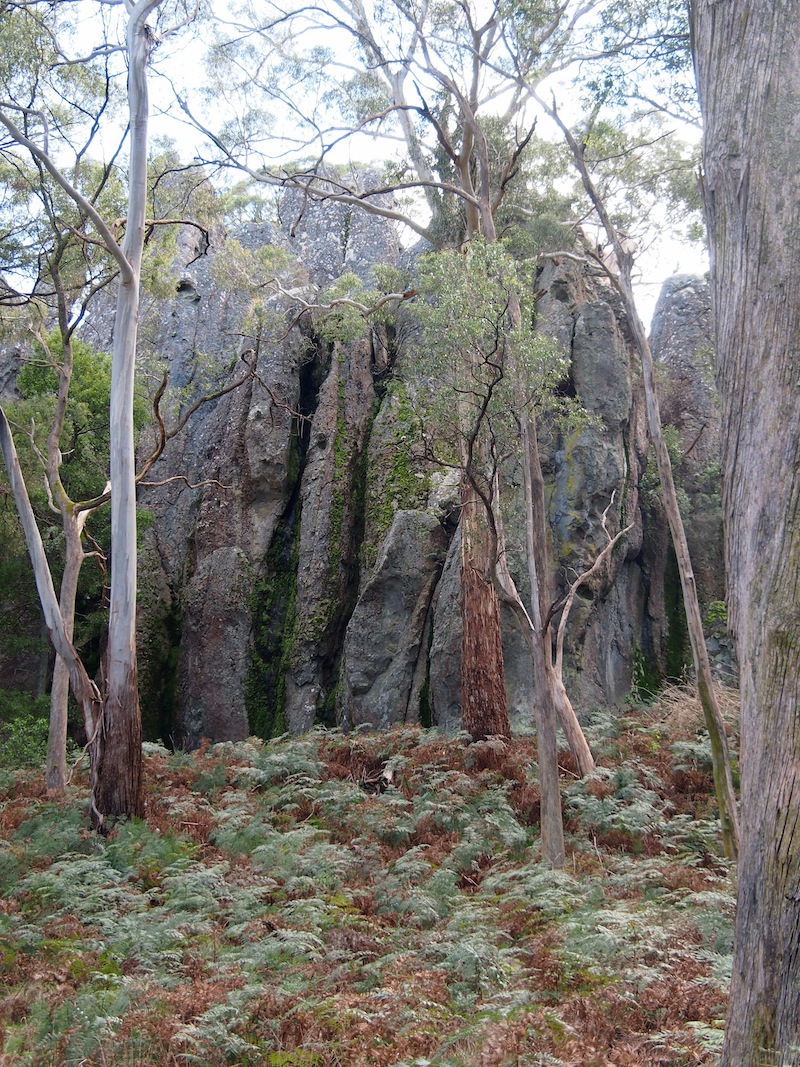
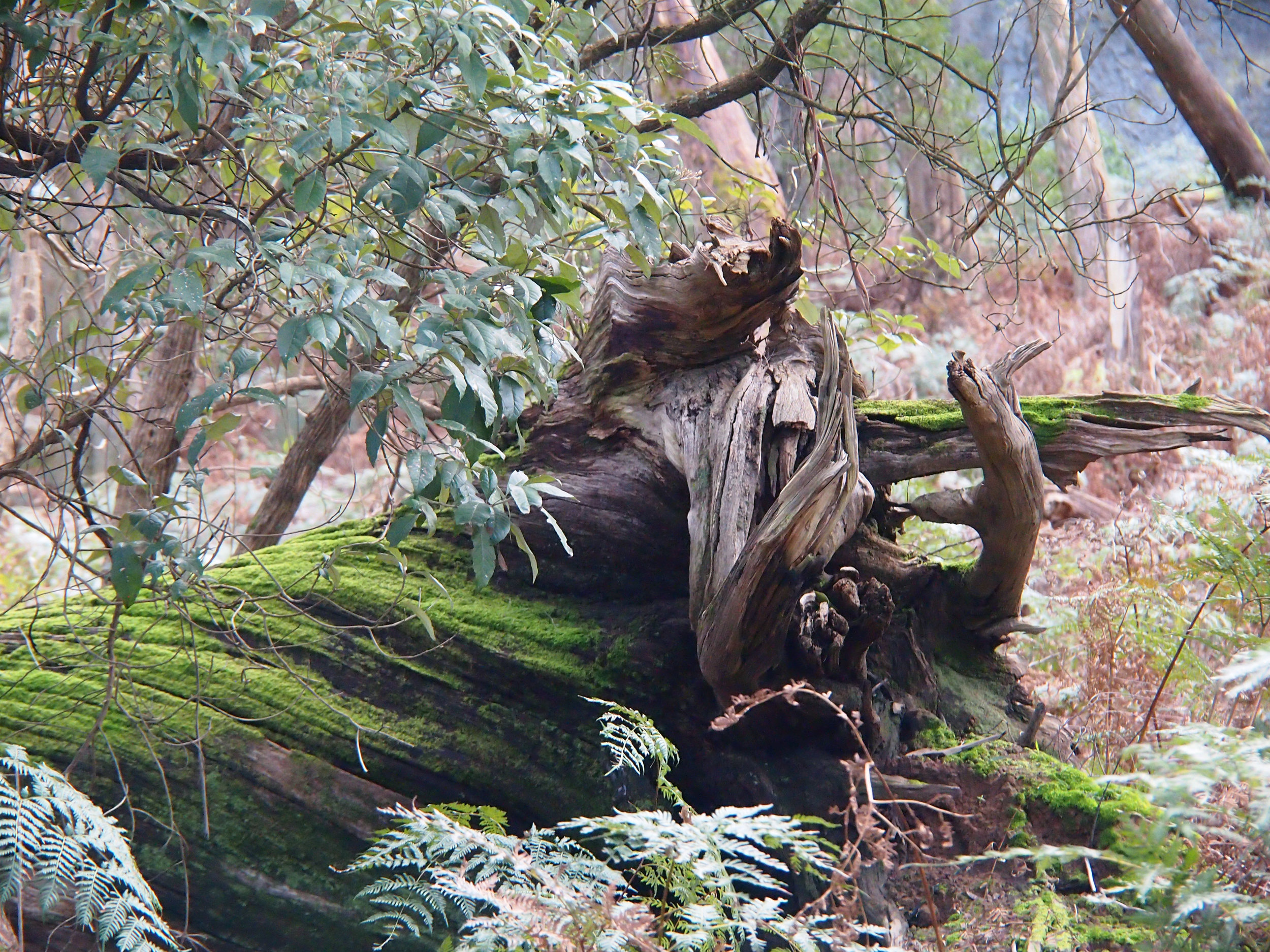
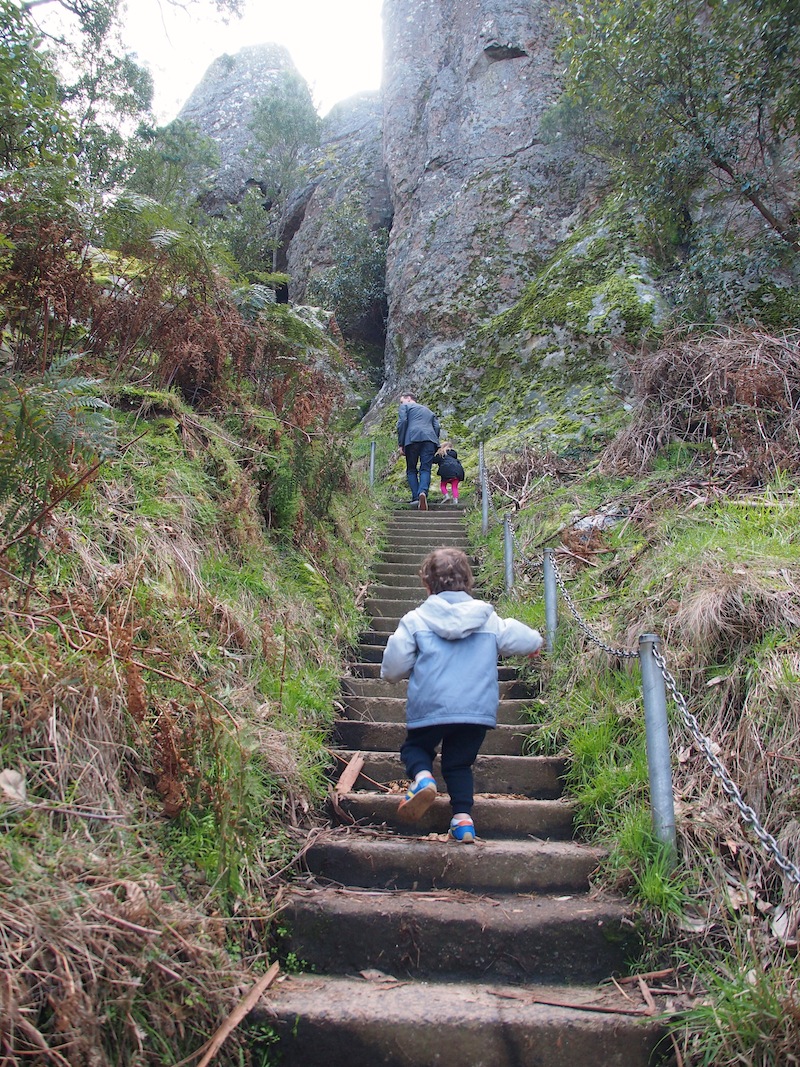
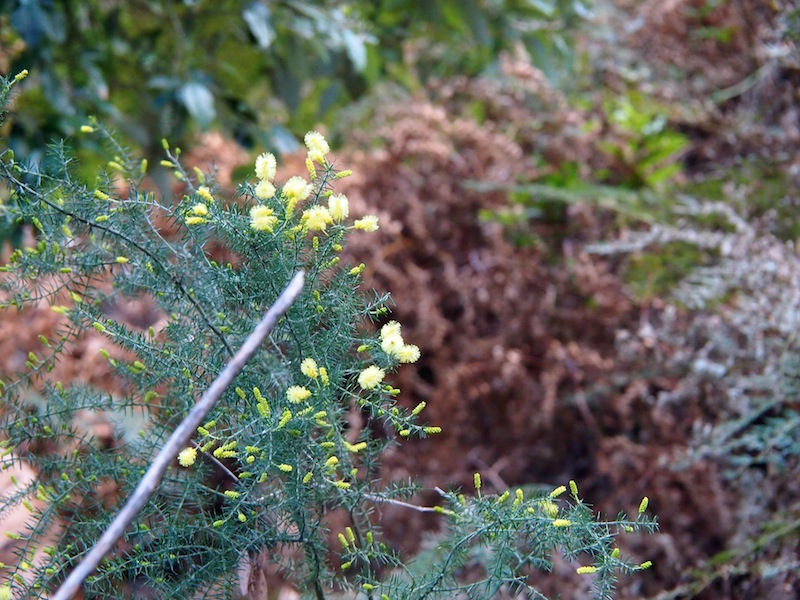
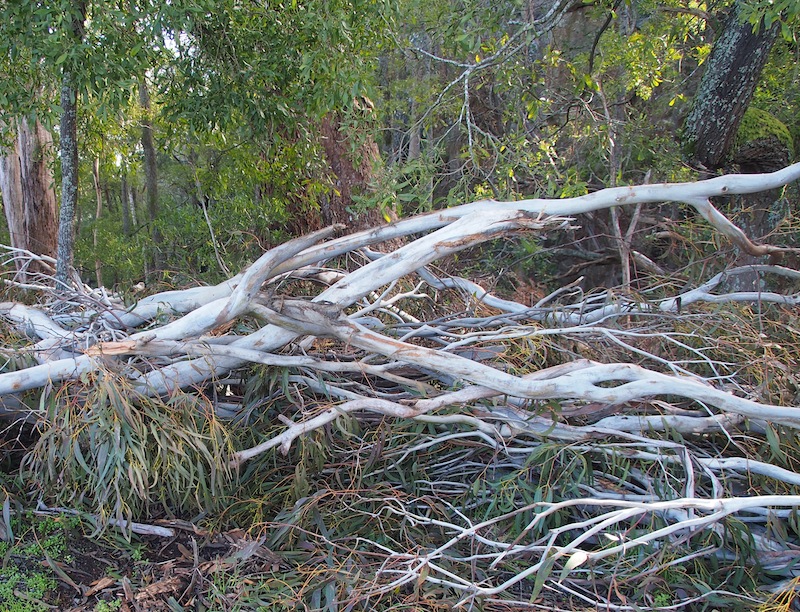
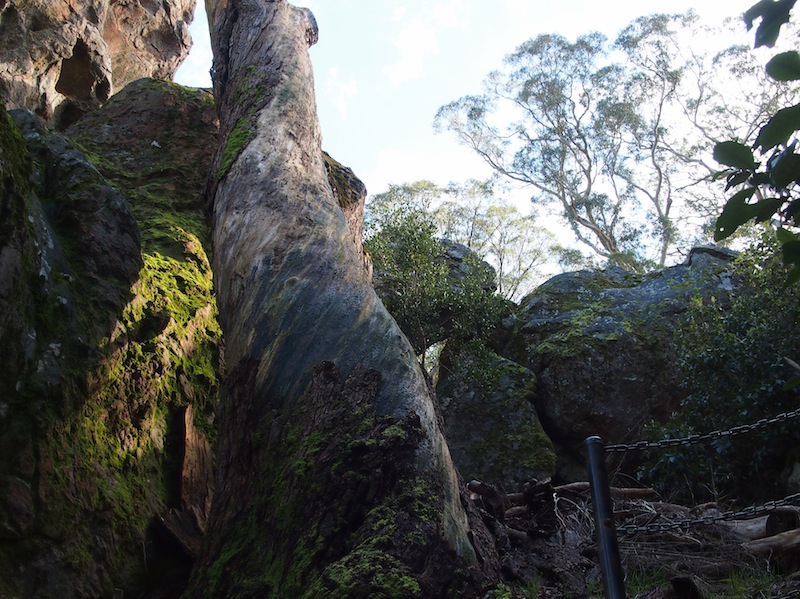
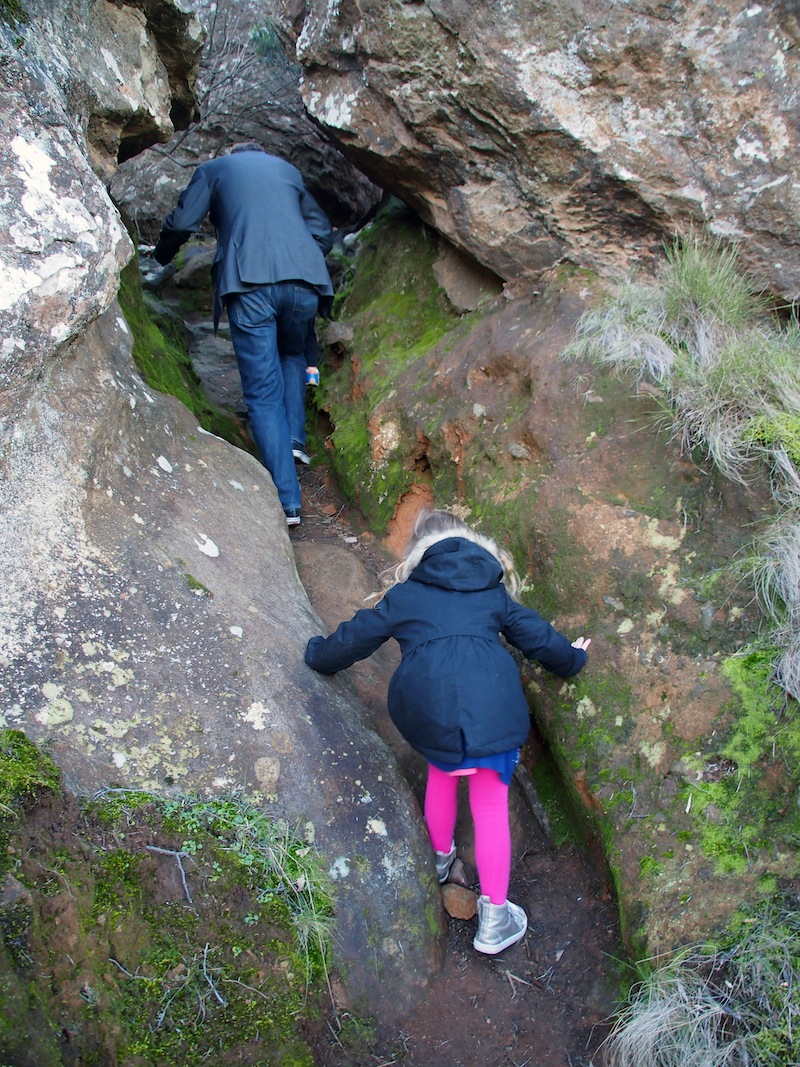
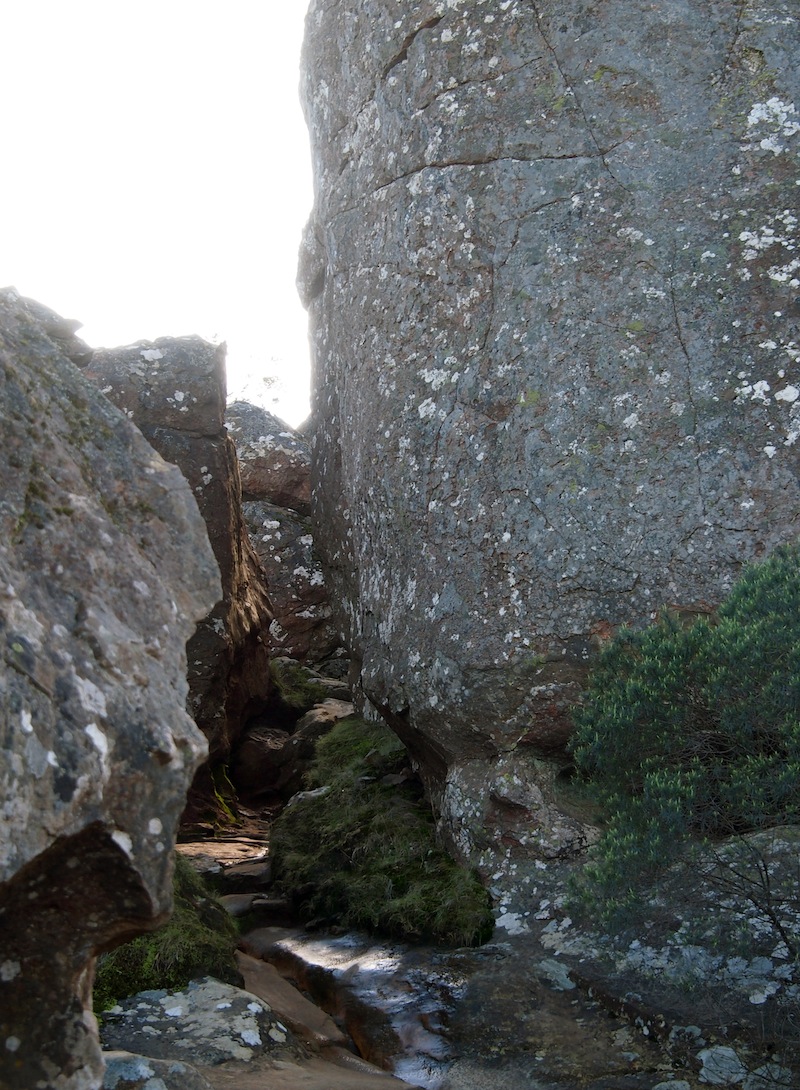
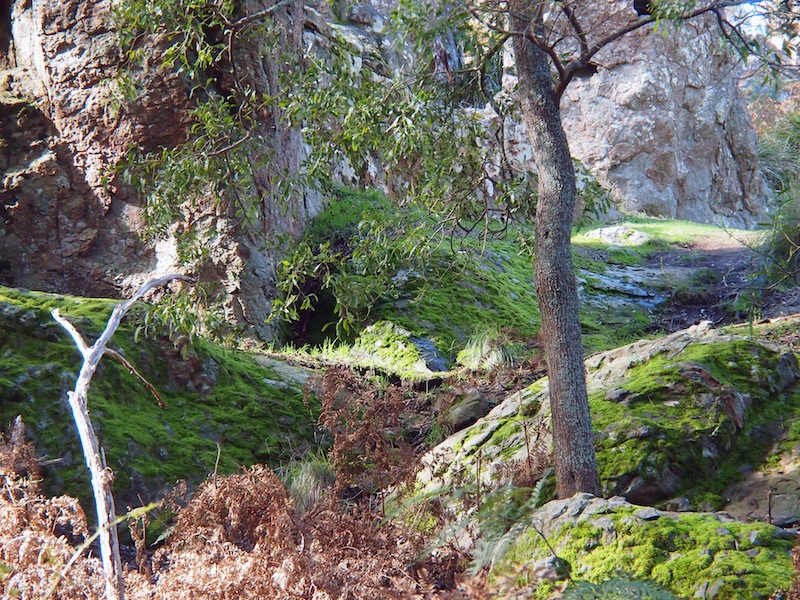
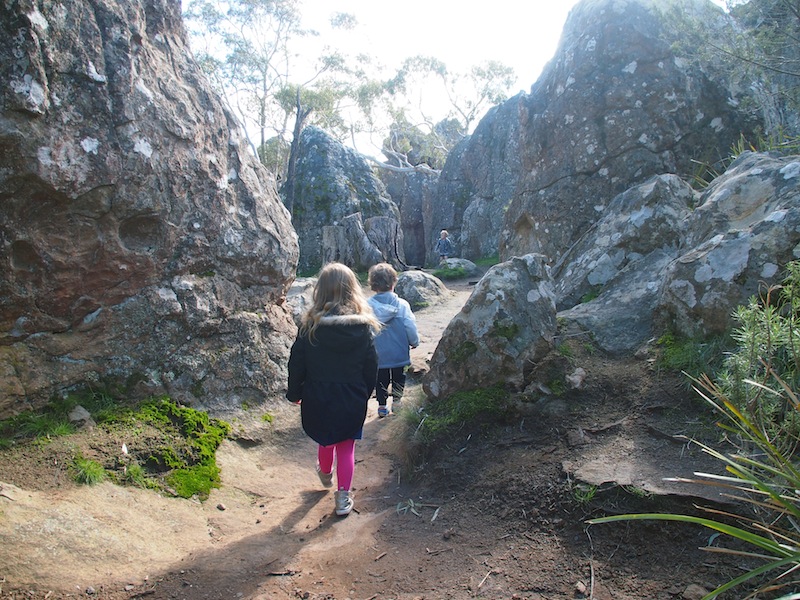
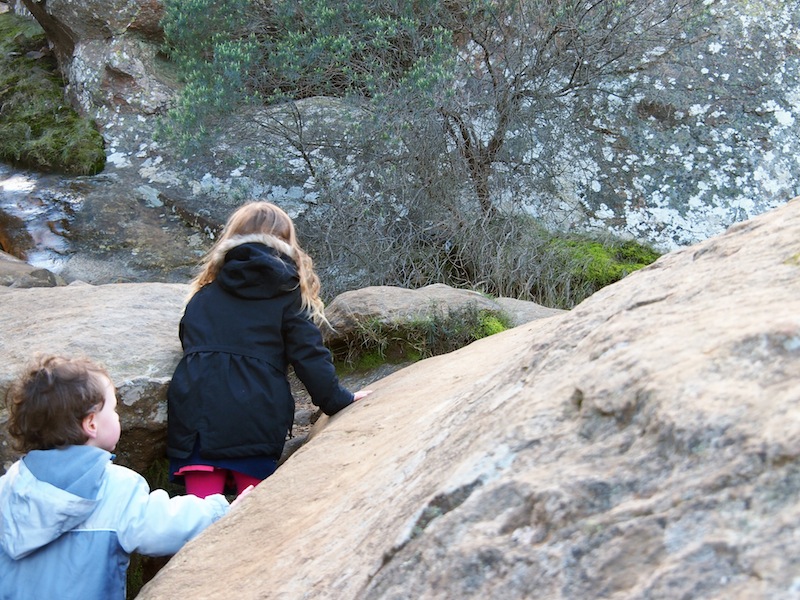

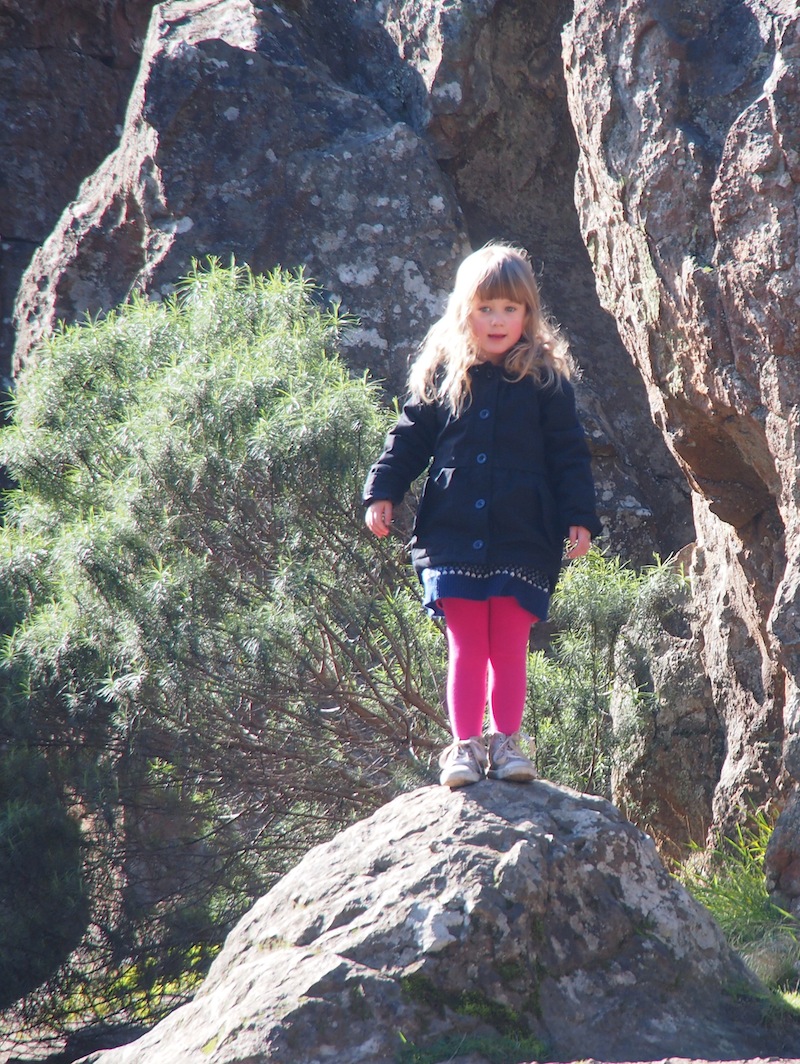
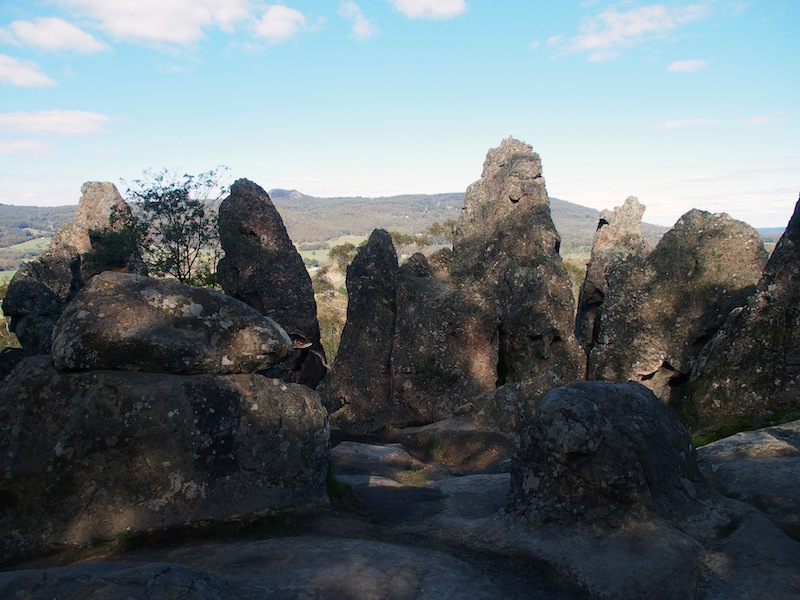
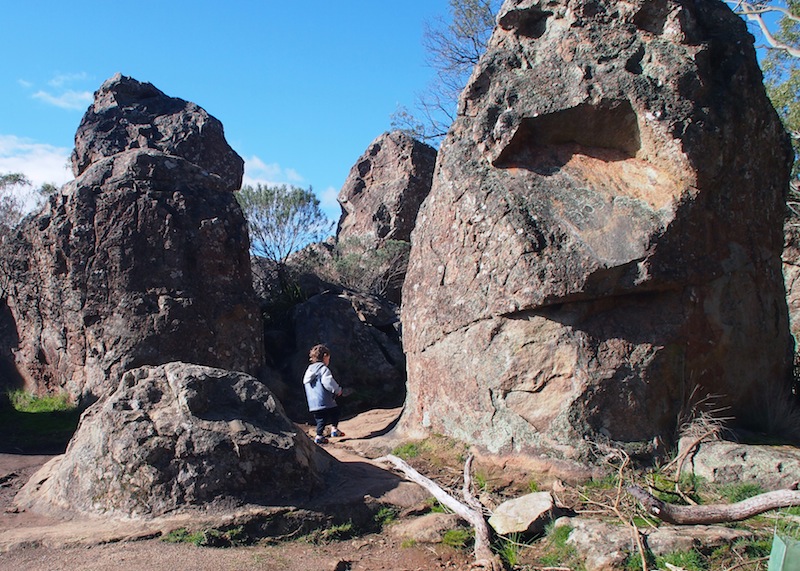
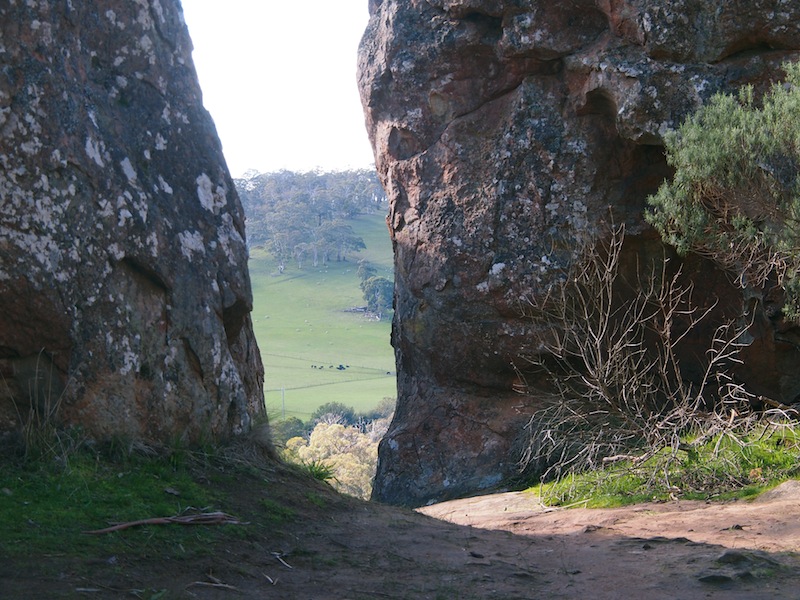
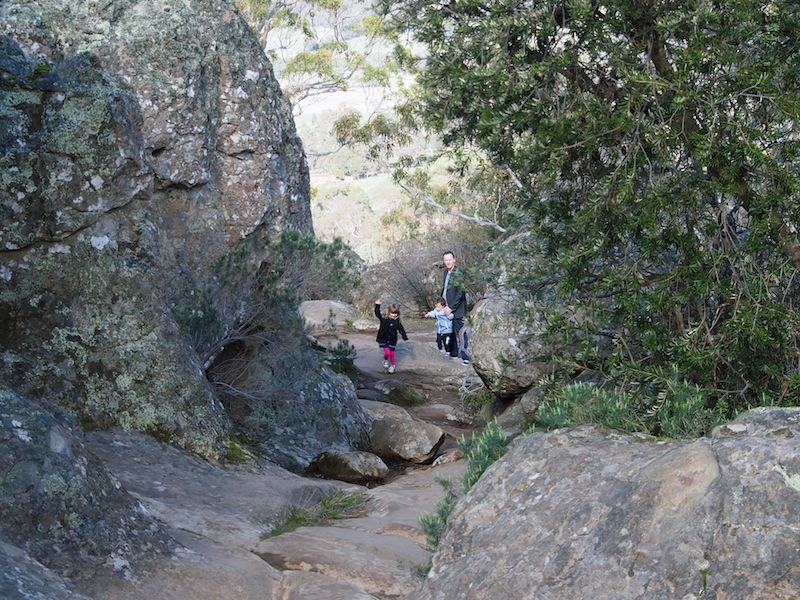
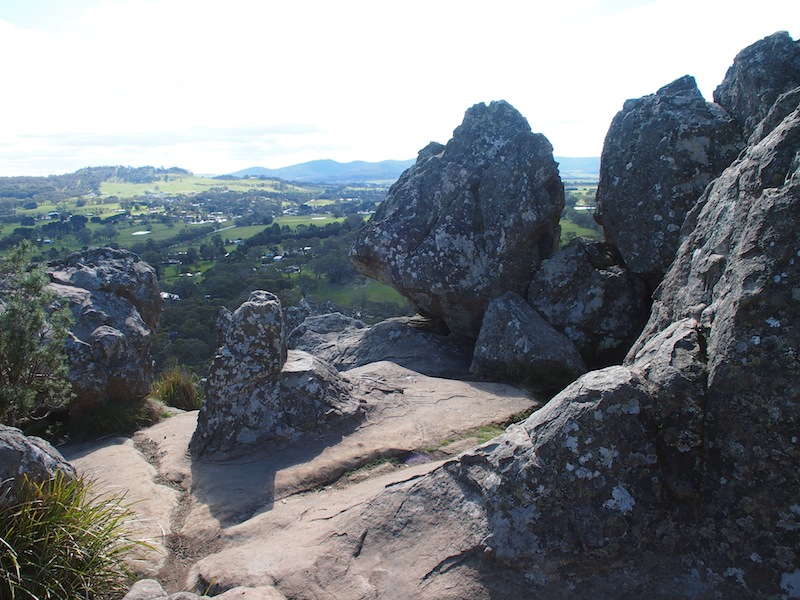
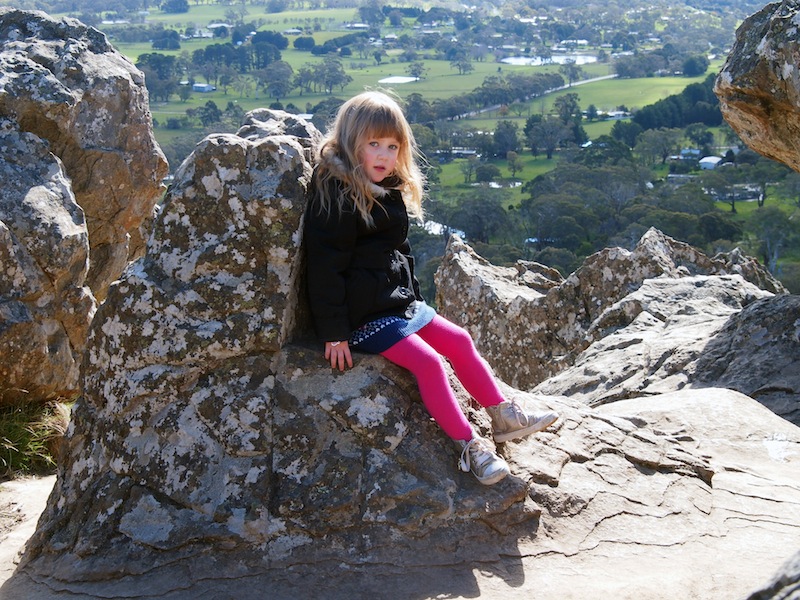
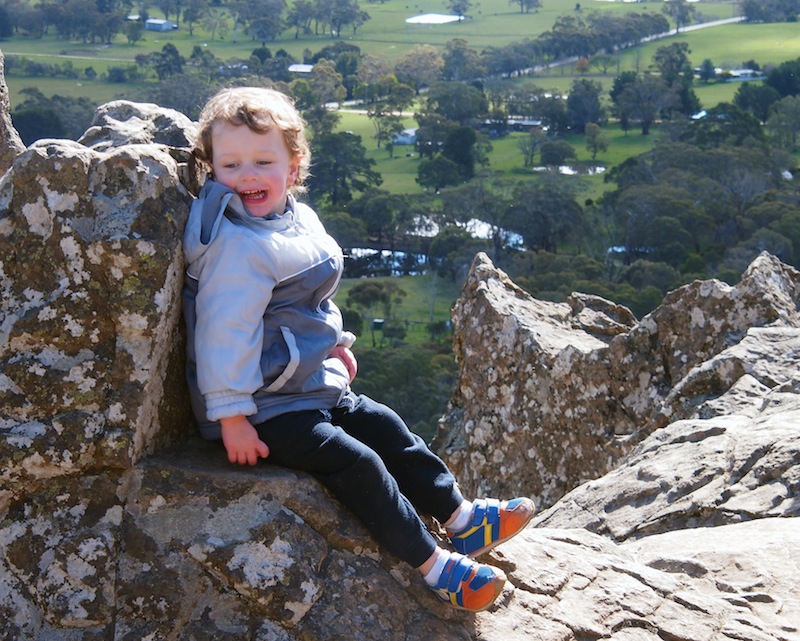
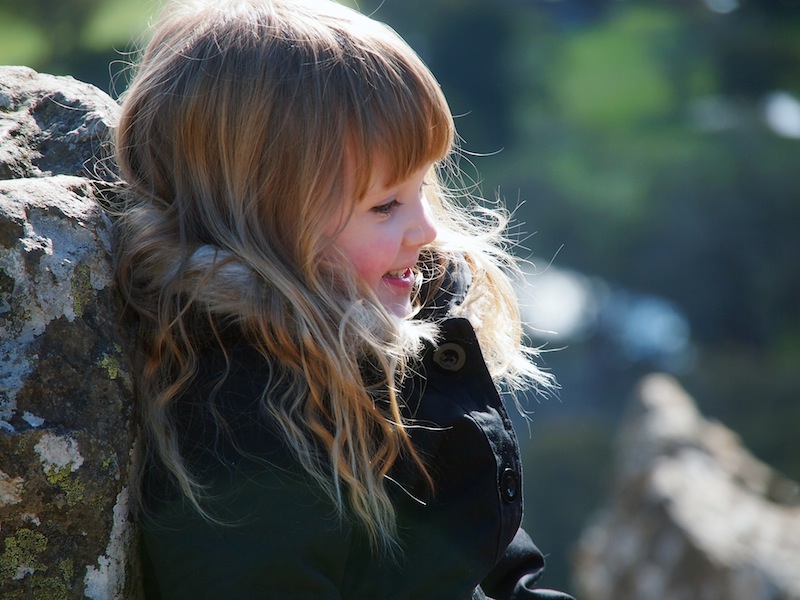
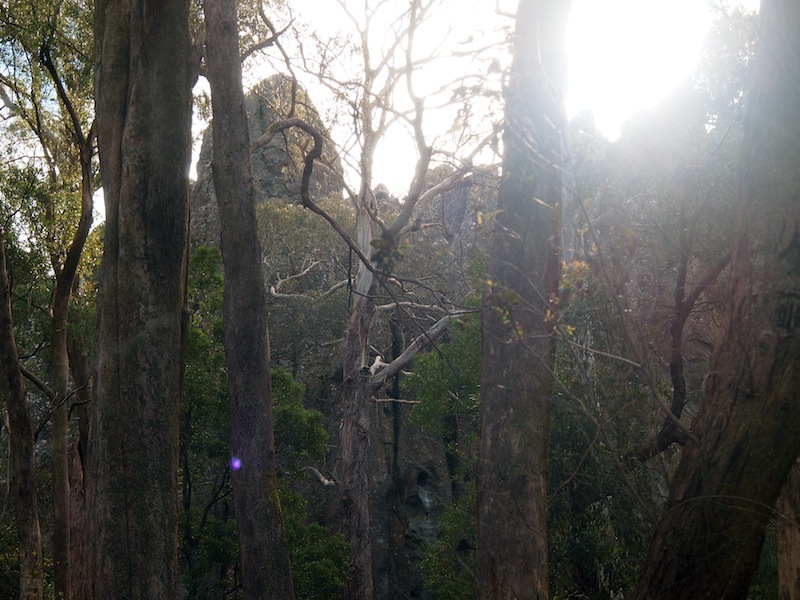
"Let's climb!" shouted Ralph. And so we climbed, free of foreboding.
In the shadow of those great rocks was no ominous hum, no sudden chill, no tingling premonition of hidden watchers' eyes. Instead, there was sunlight trickling through old bracken and ferns. Filtered water splashing out of rocks. A tiny boulder in the shape of a love-heart, wedged between two giants and framing a window to the bottom of the world.
"Let's climb!" said Ralph again. So we ventured off the pathway and scrambled over rocks and in between narrow passes and under natural bridges and, all the while, we found sunlight and clean air and great beauty... and no ghosts.
When you come alone to a place as ancient and spirit-filled as Hanging Rock, secrets whisper at you and watch you from just inside the other plane, and goosebumps come as naturally as breathing. The boundary between imagination and experience is blurred, and you are at the mercy of Place.
When you come in the company of two small children, however, it is hard to hear the spirits over the coughs and sneezes and "My legs are tired!" and "Let's have a race!" and giggles and kisses and "Can I have a banana?" and "Can you carry me?"
I thought the spirits had left Hanging Rock, at least while we were there, retreating into caves to find silence away from our relentless noise. But as I prepared these photographs last night to share with you, and I realised the ghosts had been there all along, watching, as we climbed.
Can you see them? In the strange shadows and sometimes-odd light, and in the many, many faces in the boulders?
Ahhhhh, tread lightly!

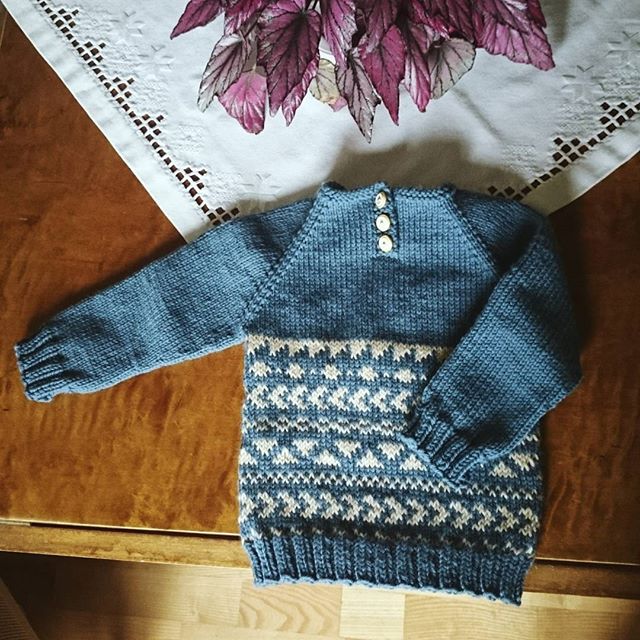 ⇑⇑
⇑⇑ 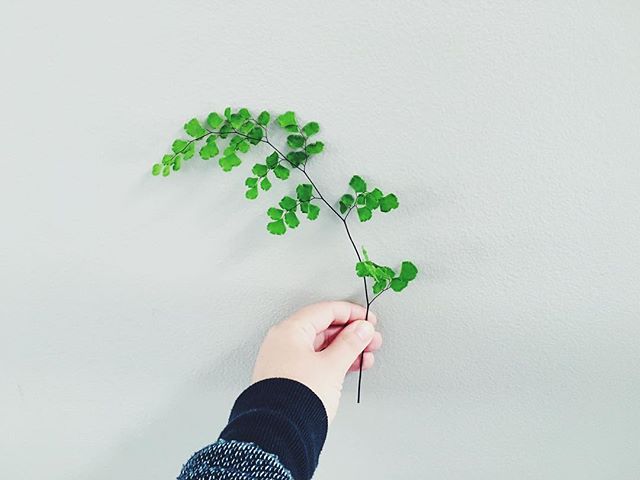 ⇑⇑
⇑⇑ 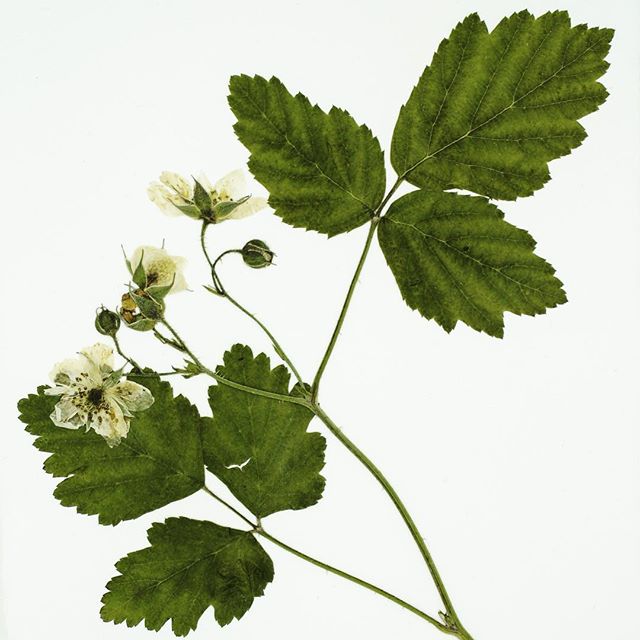 ⇑⇑
⇑⇑ 